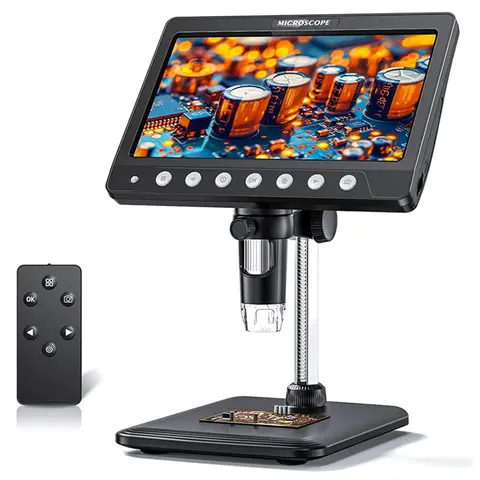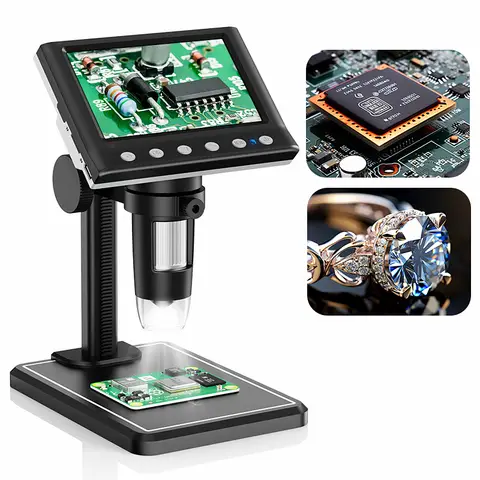Related Searches
5
Results for usb microscope
Looking for usb microscope? High resolution usb microscope, easy to operate and use. Usb microscope, portable and convenient to use. The camera module can connect the usb interface to take a picture. The usb microscope is a high quality and portable microscope that you can use for both beginners and advanced users. In addition to a wide selection of high-quality products, you can find many discounts during the promotional period. Don't forget to use the bottom of the filter to get the most out of your online shopping!
Unleash Detailed Insights With Our Top-Quality Usb Microscope – Perfect For Home Or Lab!
Introduction to USB Microscopes
In the ever-evolving world of technology, every advancement adds a new dimension to our ability to explore and understand the microscopic world. USB microscopes have revolutionized how we view tiny objects with clarity and ease. These portable and convenient tools are designed to provide a seamless experience, enabling users to examine various specimens from the comfort of their homes or offices. Whether you're a hobbyist, a professional in the field of science, or a student, a USB microscope can enhance your observational skills and open up a whole new realm of discovery.
Key Features and Benefits of USB Microscopes
USB microscopes are not just any ordinary microscopes; they come packed with features that make them user-friendly, versatile, and incredibly useful. Some of the key features include:
- High-Quality Imaging: USB microscopes are equipped with high-resolution cameras that capture images with remarkable clarity. This allows users to zoom in and out effortlessly, viewing details that might otherwise go unnoticed.
- Plug and Play Convenience: One of the standout features of USB microscopes is their simplicity. They are plug-and-play, which means they can be connected directly to a computer or tablet via a USB cable. No additional hardware is required, making them highly accessible for users of all skill levels.
- Compact and Portable Design: Designed for portability, USB microscopes are lightweight and compact, allowing users to carry them anywhere. This makes them ideal for fieldwork or for anyone who frequently moves between different workstations or locations.
- Wide Range of Magnification: These microscopes typically offer a range of magnification levels, from low to high. This flexibility allows users to adapt the magnification to suit their specific needs, whether they are examining large or small specimens.
- Adjustable Focus: USB microscopes often come with adjustable focus mechanisms, allowing users to fine-tune the image quality and ensure that every detail is sharp and clear.
- Advanced Imaging Modes: Many USB microscopes offer additional imaging modes such as phase contrast, bright field, and dark field. These modes enhance the visibility of different types of specimens, making the viewing experience more comprehensive and informative.
Applications of USB Microscopes
The applications of USB microscopes are vast and varied. From scientific research to educational purposes, these tools find use in numerous fields. Here are some of the key applications:
- Scientific Research: In laboratories, USB microscopes are invaluable for examining various samples, ranging from biological tissues to industrial materials. Researchers can use these microscopes to analyze specimens at different magnifications and capture detailed images for further analysis.
- Quality Control: In manufacturing and quality control processes, USB microscopes help in inspecting products for defects or inconsistencies. They are particularly useful in industries such as electronics, pharmaceuticals, and manufacturing where precision is critical.
- Education: For educators, USB microscopes are a fantastic tool for engaging students in hands-on learning. They can use these microscopes to demonstrate various biological, chemical, and physical concepts, making complex ideas more accessible and understandable.
- DIY and Hobbyists: For hobbyists interested in microscopy, USB microscopes offer a cost-effective and convenient way to explore the microscopic world. They can use these microscopes to examine stamps, insects, rocks, and other small objects, providing hours of entertainment and educational value.
- Medical Diagnosis: In medical settings, USB microscopes are used for preliminary diagnoses and for observing skin conditions, blood samples, and other medical specimens. They are particularly useful in dermatology and microbiology where clear, high-resolution images are crucial for accurate diagnosis.
Advantages Over Traditional Microscopes
When compared to traditional compound microscopes, USB microscopes offer several advantages:
- Ease of Use: Traditional microscopes require more setup and maintenance. They often need to be placed on a stable surface and focused manually, which can be time-consuming. USB microscopes, on the other hand, are plug-and-play, making them incredibly easy to use and set up.
- Accessibility: Traditional microscopes are often large and cumbersome, limiting their mobility. USB microscopes, with their compact and portable design, can be carried anywhere, making them ideal for fieldwork or for users who frequently move between different workstations.
- Cost-Effective: While traditional microscopes can be expensive, USB microscopes are generally more affordable. They offer high-quality imaging without the need for expensive maintenance or additional hardware.
- Integration with Technology: USB microscopes seamlessly integrate with modern technology. They can be easily connected to computers, tablets, and smartphones, allowing users to capture and share images directly. This feature is particularly useful for educational and research purposes.
- Versatility: USB microscopes are versatile and can be used for a wide range of applications, from scientific research to hobbyist exploration. Traditional microscopes may be more specialized and limited in their use.
How to Choose the Right USB Microscope
When selecting a USB microscope, it's important to consider several factors to ensure you choose the right one for your needs:
- Magnification Range: Look for a microscope that offers a wide range of magnification levels. This flexibility will allow you to adapt to different specimen sizes and types.
- Image Resolution: Ensure the microscope has high-resolution imaging capabilities to capture clear and detailed images. This is crucial for both educational and professional use.
- Connectivity Options: Check if the microscope supports multiple connectivity options, such as USB, Wi-Fi, or Bluetooth. This will give you more flexibility in how you use the microscope.
- Adjustable Focus: Opt for a microscope with an adjustable focus mechanism to ensure that the images are always in sharp focus.
- Additional Features: Look for microscopes that offer additional features such as phase contrast, bright field, and dark field imaging modes. These modes enhance the visibility of different types of specimens.
- User Reviews: Read user reviews and ratings to get an idea of the microscope's performance and durability. This can help you make an informed decision and ensure you choose a reliable product.
- Warranty and Support: Consider the manufacturer’s warranty and customer support. A good warranty and responsive support can provide peace of mind and additional value.
Conclusion: Embrace the Microscopic World with a USB Microscope
Whether you're a professional scientist, a hobbyist, or an educator, a USB microscope is a powerful tool that can enhance your observational skills and open up a whole new world of discovery. With their ease of use, portability, and high-quality imaging, USB microscopes offer an unbeatable combination of functionality and convenience. Invest in a USB microscope today and unlock the potential of the microscopic world.
See more details about usb microscope in AliExpress Video Page.










